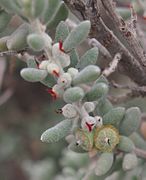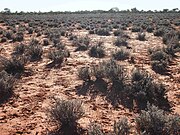| Maireana astrotricha | |
|---|---|

| |
| Foliage and fruit | |

| |
| Habit | |
| Scientific classification | |
| Kingdom: | Plantae |
| Clade: | Tracheophytes |
| Clade: | Angiosperms |
| Clade: | Eudicots |
| Order: | Caryophyllales |
| Family: | Amaranthaceae |
| Genus: | Maireana |
| Species: | M. astrotricha |
| Binomial name | |
| Maireana astrotricha (L.A.S.Johnson) Paul G.Wilson | |

| |
| Occurrence data from AVH | |
| Synonyms | |
| |
Maireana astrotricha, the low bluebush (a name it shares with Maireana planifolia), is a species of flowering plant in the family Amaranthaceae, native to a southern portion of the Northern Territory, central South Australia, western New South Wales, and adjacent parts of Queensland. It is usually found growing in open habitats, typically in gravelly, well-drained soils.
Etymology & naming
The genus Maireana was initially described by Moquin-Tandon after the French naturalist Maire. The name astrotricha comes from the Greek 'astron', meaning star and 'trichos', meaning hairs, referring to the branched hairs.
Common names include low bluebush (shared with Maireana planifolia) and infrequently southern bluebush or grey bluebush.
Description
M. astrotricha is a small, bluish-white, round shrub up to 1m high. The leaves and branches have a downy covering of branched hairs. The leaves are 5-10mm long, succulent, alternate with an obovate shape that narrows to a short stalk.
Flowers are solitary, from the leaf axil. Flowers are polygamodioecious, with the male hemispherical and the female globose. The perianth is densely tomentose on the outside, with short lobes and a radial split extending to the corolla tube. It fruits from the perianth wing, fruits are approximately 15-20mm diameter, simple, dry, papery, with a single radial slit.
It resembles and has been mistaken for pearl bluebush (Maireana sedifolia). M. sedifolia can be distinguished from M. astrotricha by its simple hairs, stalkless leaves and paired flowers.
Taxonomy
M. astrotricha belongs to the Maireana genus of 57 species. It was first described as Kochia sedifolia var. stellulata. Before description in 1951 as the separate species Kochia astrotricha it was regularly confused with low bluebush (M. planifolia) or pearl bluebush (M. sedifolia). The Australian species of Chenopodiaceae (now tribe Camphorosmeae of Amaranthaceae) within Kochia were subsequently recognised to have multiple morphologically distinct characters and were transferred to Maireana.
Distribution & habitat
M. astrotricha is found north of the Murray river, throughout western New South Wales, central South Australia, south of Alice Springs in the Northern Territory and the south western corner of Queensland adjacent to these regions. Within western NSW from the Murray to the Queensland border it gradually replaces pearl bluebush (M. sedifolia), becoming more frequent in the north. In South Australia it is found from the Northern Eyre Peninsula across to the eastern and northern borders, but not recorded on the south east or Yorke and Fleurieu peninsula.
It is usually found in well-drained gravelly or stony soil in open situations. Bluebush communities can occur in a terrain from level to gently undulating plains or dunes. M. astrotricha forms communities of one or more species, typically with M. pyramidata. Some contain bladder saltbush (Atriplex vesicaria) and can mix with adjacent A. vesicaria or mulga (Acacia aneura) communities. Bluebush communities are usually found where limestone is present in the soil.
Ecology
Bluebush (Maireana) are slow growing with deep tap roots and extremely drought tolerant. They play an important role in stabilising the landscape as they are long-lived resistant structures. Bluebush retain their leaves during drought, but can survive longer periods of drought through defoliation without killing the plant.
The central netted dragon and Leonhardi's ctenotus use M. astrotricha as a perch and shelter, but do not feed on it. The sleepy lizard uses the closely related pearl bluebush (M. sedifolia) selectively as a daytime refuge from high temperatures, suggesting that bluebush are used in the thermal ecology of some reptiles.
The chestnut-breasted whiteface relies on M. astrotricha for cover and to nest. The cinnamon quail-thrush often associates with the chestnut-breasted whiteface and also uses bluebush for nest sites and cover. The southern whiteface and banded whiteface are also found in bluebush habitat within the range of M. astrotricha. The Flinders Ranges thick-billed grasswren (Amytornis modestus raglessi) is found in M. astrotricha although it is more frequently found in black bluebush (M. pyramidata).
Reproduction & dispersal
M. astrotricha is described as flowering in late spring to summer. However bluebush (Maireana) flowering is sparing, irregular and has been observed throughout the year, usually following rainfall events.
Bluebush dispersal is not well understood. The papery wing of M. astrotricha and pearl bluebush (M. sedifolia) may facilitate wind dispersal, although one study on the similar M. sedifolia found that fruits only dispersed a few metres from the plant. Ants have been observed collecting bluebush fruit, but this may be for food and may not facilitate dispersal.
Uses
Saltbush and bluebush (Maireana) are highly regarded as reserve forage for stock as they offer more protein and digestability than dry herbaceous species. M. astrotricha is more acceptable to stock than pearl bluebush (M. sedifolia).
Gallery
References
- ^ "Maireana astrotricha (L.A.S.Johnson) Paul G.Wilson". Plants of the World Online. Royal Botanic Gardens, Kew. Retrieved 27 August 2022.
- ^ George, Alexander S. (1984). Flora of Australia: Volume 4; Phytolaccaceae to Chenopodiaceae (PDF). Canberra: Australian Government Publishing Service. p. 198.
- ^ Wilson, Paul Graham (1975). "A taxonomic revision of the genus Maireana (Chenopodiaceae)". Nuytsia. 2 (1): 2–82. doi:10.58828/nuy00028. Retrieved 9 June 2024.
- ^ "Species Information - Maireana astrotricha". Seeds of South Australia. South Australia Seed Conservation Centre, Botanic Gardens Adelaide. Retrieved 13 June 2024.
- ^ Cunningham, Geoffrey M (2011). Plants of western New South Wales. Collingwood: CSIRO publ. pp. 265–267. ISBN 9780643103634.
- Cunningham, Geoffrey M (2011). Plants of western New South Wales. Collingwood: CSIRO publ. p. 274. ISBN 9780643103634.
- ^ Wotton, Noelene Joy (1993). Aspects of the autecology of the pearl bluebush, Mairenana sedifolia (Ph.D. thesis). University of Adelaide, Dept. of Botany. hdl:2440/21149. Retrieved 8 June 2024.
- "Species: Maireana astrotricha (Low Bluebush)". Atlas of Living Australia. Retrieved 8 June 2024.
- Black, J. M. (1915). "Scientific notes on an expedition into the north-western regions of South Australia". Transactions and Proceedings of the Royal Society of South Australia. 39: 828. Retrieved 14 June 2024.
- ^ Cunningham, Geoffrey M (2011). Plants of western New South Wales. Collingwood: CSIRO publ. p. 21. ISBN 9780643103634.
- ^ Harrington, G. N.; Wilson, A. D.; Young, M. D. (1984). Management of Australia's rangelands. Canberra, ACT: Division of Wildlife and Rangelands Research, CSIRO. pp. 209–222. ISBN 9780643036154.
- MacMillen, Richard E.; Augee, Michael L.; Ellis, Beverly A. (1 March 1989). "Thermal ecology and diet of some xerophilous lizards from western New South Wales". Journal of Arid Environments. 16 (2): 193–201. Bibcode:1989JArEn..16..193M. doi:10.1016/S0140-1963(18)31026-7.
- Read, J. L. (December 1995). "Subhabitat variability: A key to the high reptile diversity in chenopod shrublands". Australian Journal of Ecology. 20 (4): 494–501. doi:10.1111/j.1442-9993.1995.tb00568.x.
- Kerr, Gregory D.; Bull, C. Michael; Burzacott, Dale (April 2003). "Refuge sites used by the scincid lizard Tiliqua rugosa". Austral Ecology. 28 (2): 152–160. Bibcode:2003AusEc..28..152K. doi:10.1046/j.1442-9993.2003.01268.x.
- Higgins, P. J. (2002). "Chestnut-breasted whiteface". In Higgins, P. J.; Peter, J.M (eds.). Handbook of Australian, New Zealand and Antarctic birds: Pardalotes to Shrike-thrushes (Vol. 6 ed.). Melbourne, VIC: Oxford University Press. pp. 561–567.
- Higgins, P. J. (2002). "Cinnamon quail-thrush". In Higgins, P. J.; Peter, J.M (eds.). Handbook of Australian, New Zealand and Antarctic birds: Pardalotes to Shrike-thrushes (Vol. 6 ed.). Melbourne, VIC: Oxford University Press. pp. 980–990.
- Higgins, P. J. (2002). "Southern whiteface". In Higgins, P. J.; Peter, J.M (eds.). Handbook of Australian, New Zealand and Antarctic birds: Pardalotes to Shrike-thrushes (Vol. 6 ed.). Melbourne, VIC: Oxford University Press. pp. 550–560.
- Higgins, P. J. (2002). "Banded whiteface". In Higgins, P. J.; Peter, J.M (eds.). Handbook of Australian, New Zealand and Antarctic birds: Pardalotes to Shrike-thrushes (Vol. 6 ed.). Melbourne, VIC: Oxford University Press. pp. 568–574.
- del Hoyo, Josep; Collar, Nigel; Kirwan, Guy M. (2020). "Thick-billed Grasswren (Amytornis modestus), version 1.0". Birds of the World. doi:10.2173/bow.thbgra4.01. Retrieved 10 June 2024.
| Taxon identifiers | |
|---|---|
| Maireana astrotricha |
|
| Kochia astrotricha | |

